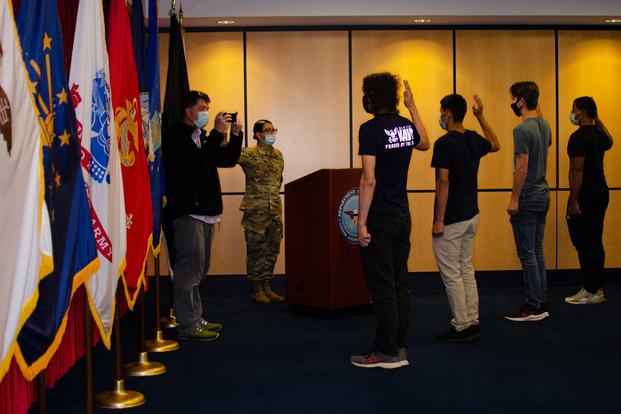A new study by Rand Corp. released Tuesday shows that, while the pandemic made it harder for the military services to recruit new personnel, overall numbers actually increased.
According to the paper, the Army, Navy and Air Force all managed to increase the number of troops in their ranks in 2020 compared to the year before, despite a downturn in new enlistments.
After reviewing data provided to Rand by the Department of Defense, the researchers noted that the initial drop in the number of recruits moving through training and the number of enlistment contracts being written happened between March and April 2020, "a period when each of the services placed restrictions on in-person recruiting activities to curb the spread of COVID-19."
Read Next: Feared Increase in Suicides Among Troops After Afghanistan Exit Hasn't Materialized
However, each service maintained or improved the quality of its candidates, the article notes.
Earlier this month, the Army announced that it is offering a maximum enlistment bonus of $50,000, a record, to highly skilled recruits who join for six years..
The Rand paper draws few definitive conclusions about what caused the trends in recruiting and retention but does offer some theories.
"We believe that restrictions on in-person recruiting were more likely to be responsible for the decrease in contracts and accessions during [fiscal year] 2020 than a change in young people's willingness to serve in the military," the paper said.
Meanwhile, the authors also suggest that an increased unemployment rate, as well as a drop in the number of injury-causing exercises, could be responsible for some of the extra retention.
"If the services were concerned about failing to meet their accession mission during the pandemic, they may have allowed more members to stay, thereby increasing retention," the article added.
The authors also noted that their analysis didn't take into account changes in how many resources the branches devoted to recruiting, the state of the economy, or "other factors that past research shows affect individuals' decisions to join or remain in the military."
For example, in discussing the Army's efforts, the paper explained that the addition of COVID restrictions to recruiting should have caused the number and quality of recruits and contracts to fall. "However, the dramatic rise in youth unemployment likely increased the incentive to enlist, which means that the expected direction of changes in contracts and accessions is ambiguous."
The outlier in the trends in the data was the Marine Corps, which not only saw a drop in its end strength figures but also its enlistment rate and retention rate. The authors suggest that this is "more likely linked to a new force restructuring plan that began at the same time as the COVID-19 pandemic."
Part of that plan -- Force Structure 2030 -- is to make the Corps an older, more agile and talent-driven force with a greater emphasis on retaining people instead of recruiting replacements.
Given the data, the authors concluded that "the services primarily focused on retention in order to meet their end strength goals during the COVID-19 pandemic."
-- Konstantin Toropin can be reached at konstantin.toropin@military.com. Follow him on Twitter @ktoropin.
Related: How the Pandemic Changed Military Recruiting Forever











